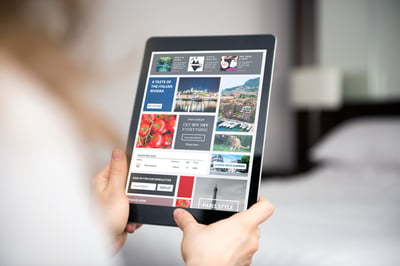January 14, 2020
 by Adelina Karpenkova / January 14, 2020
by Adelina Karpenkova / January 14, 2020
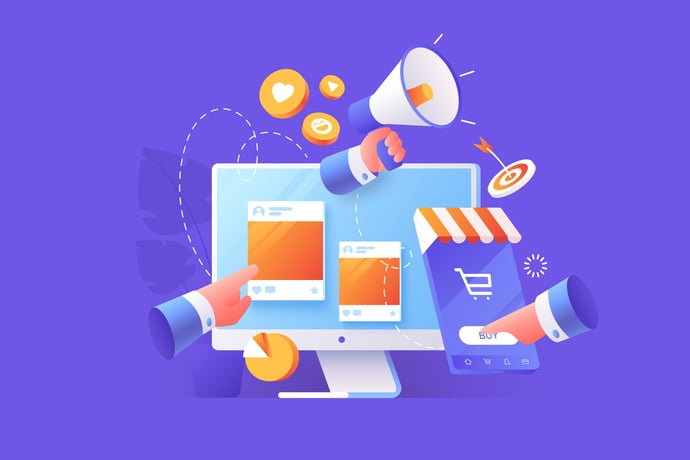
Advise, don't advertise.
Isn't it fun to be able to window-shop freely without anyone breathing down your neck, forcing you to get something out of your will? Well, that's exactly how native advertising works. It exposes you to products or services you might like in a non-intrusive and natural manner.
In the era of banner blindness, when it’s becoming more and more challenging to reach your audience with traditional ads, native advertising is on the rise. And if you are wondering how to hop on the trend, native advertising software is your answer.
Native advertising is a digital marketing approach involving paid advertisements that fit seamlessly into the surrounding content of the website they’re displayed at.
While good old display ads have been widely used for over 20 years, we only learned the term ‘native advertising’ in 2011. How did it happen that this relatively new advertising technique accounted for a $36.07 billion increase in spending in the US from 2016 to 2020?
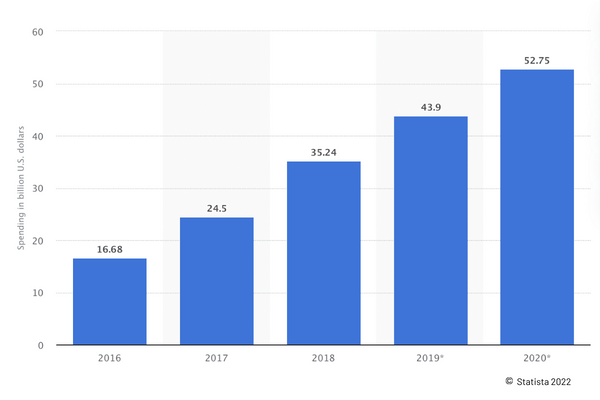
To understand why this newcomer outran traditional display ads and how this promising approach could strengthen your digital marketing strategy, it’s time to check out the major benefits of native advertising.
Native ads are the most non-intrusive type of advertisement because they easily gel in the surrounding content, making it feel less forced and more organic. It helps the customers feel more empowered and supports the growth of your brand's revenue, engagement, and awareness. Some benefits of native ads are:
First and foremost, native ads proved a great content distribution technique. Whatever type of content you want to promote, you can be sure you’ll reach the relevant audience with well-crafted native ads.
How is native advertising aligned with a marketing funnel? A marketing funnel is a model that describes every stage of your buyer’s journey from the moment they discovered your brand to conversion.
Let’s take a look at the marketing funnel to have a better idea of how it aligns with your content marketing.
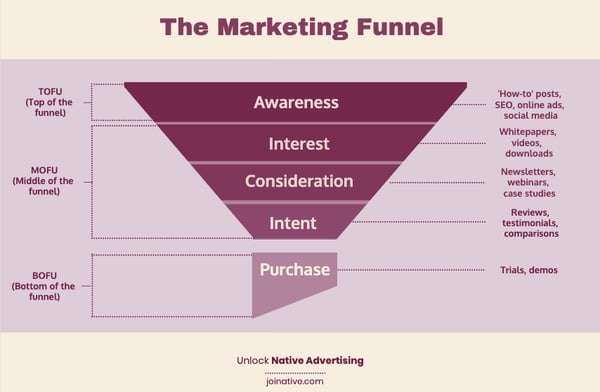
Depending on the marketing funnel stage, there's a specific type of content to support it.
Creating top-of-the-funnel (TOFU) content that builds brand awareness and nurturing leads with your middle-of-the-funnel (MOFU) content, you gently drive them to buy with the bottom-of-the-funnel (BOFU) content. The final stage often requires personalized product-focused content used by your sales team.
We’ll take a closer look at how native advertising promotes ToFu, MoFu, and BoFu content, leading your prospects to the purchase stage.
The top of the funnel is where your prospecting customers acknowledge their problem, start looking for the decision, and ‘suddenly’ come across your brand. The content you create at this stage should focus on a wide range of prospects and talk about their subject of interest but not about your brand.
The top-of-the-funnel content aims to bring in new leads and build trust, answer the audience’s common questions, and educate them.
You'll need to leverage different content distribution techniques to put this content in front of an audience that has never heard of your brand. Using the opportunity to target billions of relevant users, native advertising is one of the most effective techniques for distributing top-of-funnel content.
It’ll help you reach the basic goals you set at the awareness stage: targeting new customers, building awareness, entering new markets, and generating leads.
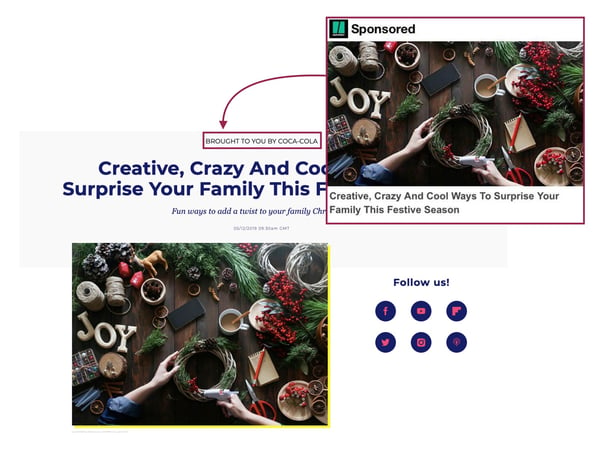
Coca-Cola’s native ad offers HuffPost readers to check out creative and crazy ways to surprise their family during the festive season.
During the next phases, the customer realizes there are different solutions to their problem and starts looking for the best one.
Your MOFU content should target educating your customers and showing them how they can solve their problems themselves. At the same time, you might want to highlight how much faster they could address it with your product or service.
If you go with native advertising at this stage, the campaign creation process might be a bit different from the awareness stage. First, you’d rather change the targeting settings and opt for retargeting, this option lets you re-engage your recent website visitors, existing customers, or subscribers of your email list.
Secondly, your goals will differ a lot. While different native advertising platforms allow you to set different objectives, here are several basic goals you’ll reach using native ads to promote your mid-funnel content: increase purchase intent, build trust and retarget leads.
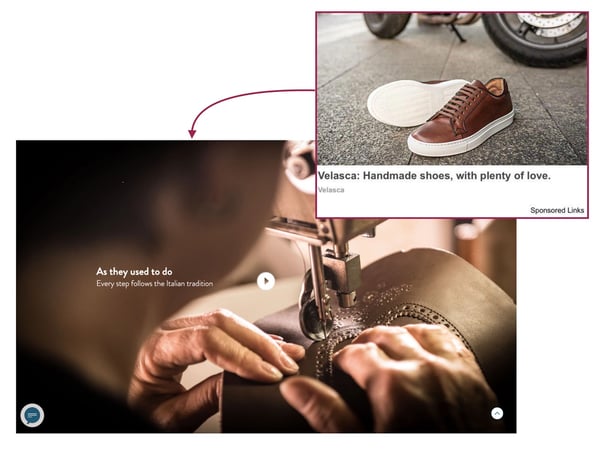
Velasca uses native ads to promote its landing page, illustrating the shoemaking process and telling about the company’s values.
At this stage, your prospects make it right to the conversion. Native ads promoting BOFU content may lead to landing pages that offer eBook downloads, app installation, free consultation, or coupons.
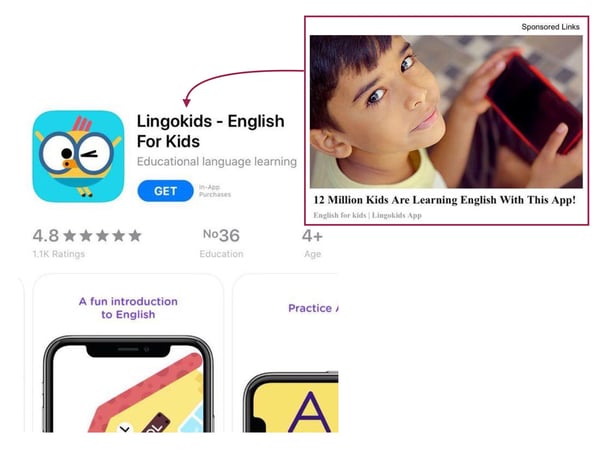
The native ad saying ‘12 Million Kids Are Learning English With This App’ leads to the language learning application in the App Store.
As you can see, native advertising isn’t just another advertising method. It’s an actionable approach to content promotion, helping marketers reach multiple goals.
It’s no secret that people hate ads. I hate them, too. The number of active ad-blockers can prove it. But I have nothing against well-crafted native ads (as well as against the badly-crafted ones, to be honest). Moreover, most of you don’t mind them, either. In fact, people look at native ads 53% more frequently than display ads. Why's that?
Well, banner ads interrupt your browsing experience at every turn: they pop up, autoplay videos, dramatically increase page load time, and so on. It often seems they’re created with one goal in mind: irritating users.
Native advertising is drastically different. The fact the ads match the form and the function of the website they appear within makes them as minimally intrusive as possible.
As mentioned before, native ads are extremely useful for promoting top-of-the-funnel content. But how people interact with this content matters the most for your brand awareness.
As native ads are woven into different types of content: educational, emotional, and visual, it has a great chance of going viral. Although people rarely share highly promotional content (unless they’re marketers), many of them happily share useful or entertaining content. So while you only pay for native ads to be shown, your readers might go further, sharing your content and promoting your brand for free.
Native advertising lets you distribute content and reach the widest possible audience. Along with building brand awareness, it’s your chance to create a relationship that builds trust and loyalty.
Of course, native ads don’t always look credible. It’s all about the content you promote with your ads. If it has no value to the reader, no epic advertisement will fix it. However, quality content displayed on trustworthy websites, such as The Guardian, Daily Telegraph, or HuffPost, will help you establish your brand as a niche expert.
It’s also worth mentioning that you can promote not only your blog posts or other owned media resources but also display your articles on the publishers’ websites. Although the post will be marked with the ‘sponsored’ label, it’ll still match the form of the editorial content and look credible.
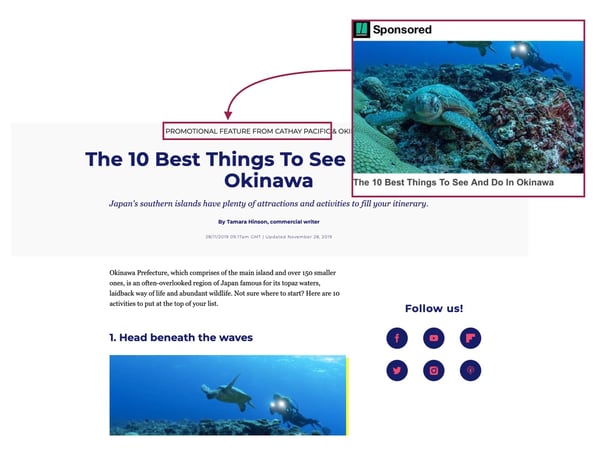
The native ad provided by Cathay Pacific & Okinawa and displayed among sponsored links on HuffPost leads to the article published on HuffPost looking like the editorial content of the magazine.
Last but not least – it's effective. It’s the biggest reason to consider including native advertising in your digital marketing strategy. Native advertising drives higher engagement than traditional display advertising. Native ads have higher acceptance rates, click-through rates, and purchase intent. Below are some statistics that prove its effectiveness.
According to Outbrain:
And more research has found that:
Although there are plenty of benefits with native advertising, marketers may face challenges with performance measurement and finding the talent and time.
Measuring key performance indicators (KPIs) such as return on investment (ROI), effectiveness, and impact with native campaigns is challenging due to their unique format. However, with the right tools and analytics method, one can make up for the lack of unified standards and track metrics like impressions, CTR, and clicks to understand the campaign's progress.
As opposed to traditional ads, with native ads, you are trying to be seen without being too pushy, make a sale without being too salesy, present a product or service without disrupting the user experience and do all that while spiking the consumer's interest. Sounds like a lot, right? And that is exactly why creating native ads requires multiple review rounds and collaboration from advertising professionals, marketing teams, copywriters, and designers.
The discrete messaging in native ads can be deceptive at times, and coming across dishonest messaging can be viewed as unethical. To avoid tricking the users into believing the advertisement is anything other than what it is, the usage of disclaimers like sponsored, paid, and the ad is encouraged. The Federal Trade Commission (FTC) has a guide on native advertising that offers guidance on following the best practices and keeping unfair practices in check.
Native advertising can be incredibly effective when done right. To reach your goals with it, you need to ensure that the following criteria are met:
Every day, people are bombarded with advertisements online, and getting the attention of your customers isn't as easy anymore. Here are some advertising techniques that will make you stand out and have all eyes focused on your brand.
Adelina is a Content Marketer at Joinative, a native advertising agency and SaaS. She’s responsible for building marketing partnerships, establishing content collaborations, and developing actionable resources for advertisers.
Looking for an advertising channel with a high level of audience engagement and low...
 by Adelina Karpenkova
by Adelina Karpenkova
You know what’s harder than skipping ads on streaming platforms? Reaching your audience...
 by Soundarya Jayaraman
by Soundarya Jayaraman
Advertising allows brands to communicate with potential customers.
 by Sagar Joshi
by Sagar Joshi
Looking for an advertising channel with a high level of audience engagement and low...
 by Adelina Karpenkova
by Adelina Karpenkova
You know what’s harder than skipping ads on streaming platforms? Reaching your audience...
 by Soundarya Jayaraman
by Soundarya Jayaraman
